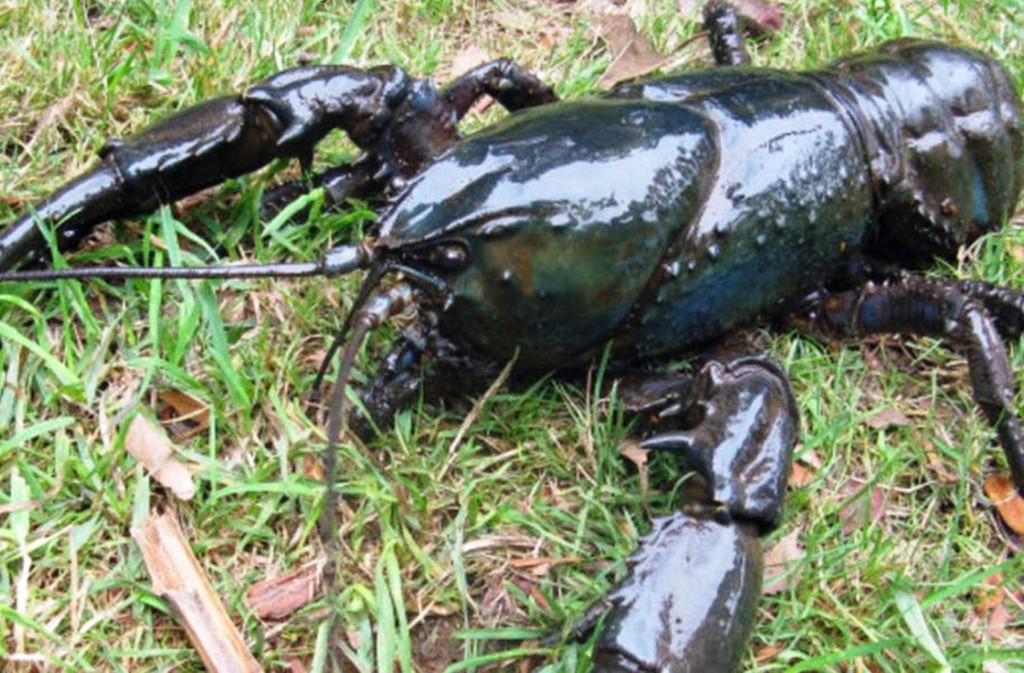Giant Tasmanian Freshwater Crayfish
by Carl Hyland on 13 Mar 2012

Lobster of this size are now hard to find. Carl Hyland
Astacopsis gouldi found only in Tasmania, this species once upon a time was hunted to near extinction, mainly for its huge size and toothsome flesh. Luckily, Tasmanian authorities saw its plight and had the foresight to list the species as endangered some years ago.
Giant freshwater crayfish commonly reach 120 mm in carapace length, although they may get up to 400 mm. They do not grow to this size quickly, but can live around 30 years. This is the largest known freshwater invertebrate, commonly reaching 500g and occasionally reaching 6 kg. (per I.F.S)
Astacopsis gouldi is territorial. Males maintain a harem of several females. Hatchlings are a mere 6 mm long, and mature extremely slowly, living for up to 40 years. Reproductive maturity occurs at around nine years in males and 14 years in females, with females breeding just once every two years. Mating occurs in autumn and the eggs, attached to the female’s swimming legs during development, hatch the following summer, remaining attached to the swimming legs as hatchlings for another month. Such a long reproductive process means that females spend much of their life with their young attached to their legs – a good strategy as fully grown adults have no natural predators. However, fishing of adult crayfish by humans results in the removal of not only the adults but all their young as well.
The giant freshwater crayfish is omnivorous, eating primarily rotting wood and animal flesh, as well as leaves and insects that fall into the water. Juveniles tend to hide in shallow water where they are less at risk from their large predators including fish and platypuses. Adults hide under submerged logs in deep pools where they appear to tolerate each other, despite being aggressive elsewhere.
These crustaceans inhabit dark, slow-moving rivers and streams with high water quality and little suspended sediment, as well as still, deep pools with logs and overhanging banks to shelter beneath. The water needs to be below 18°C with high oxygen content.
The giant freshwater crayfish was previously found in all rivers that flow into the Bass Strait, which runs between Tasmania and the Australian mainland. Today, however, the distribution is patchy and limited to less disturbed areas. They are also found in the Arthur River system.
The major threat to this species has been over-fishing, since these crayfish are a popular food dish, but this has not been sustainable due to extremely slow maturation and infrequent breeding. Habitat loss is also a threat, as a result of increasing agricultural expansion, forestry operations and changes in water quality. In-stream barriers have reduced the dispersal potential of the crayfish and erosion following agricultural expansion has caused silty water, which is less favourable for the giant freshwater crayfish.
The decline of giant freshwater crayfish numbers resulted in a fishing ban in January 1998, although an ongoing commitment is needed in order for the crayfish to recover from its endangered status. Population surveys and behavioural research are being undertaken in order to be able to provide better habitat protection and improved management of riverbank vegetation.
This species was listed as 'vulnerable' under Australian law in 1995, and it is now illegal to catch A. gouldi without a permit, carrying a maximum fine of A$10,000.
I used to capture these beautiful creatures once upon a time and found them very easy to take, my largest was around 2kg.They are still quite prevalent in locations such as Golconda and the North East where the Little Forester River flows. A sanctuary was established some years ago in Caroline Creek in the state’s North West.
More information is available from the Inland Fisheries website.
Thanks to the swift reporting by a member of the public last month, the lives of two giant freshwater crayfish have been saved. As a result of the report, which detailed someone behaving suspiciously at inland water in the North West of the State, the alleged offender, who was found in possession of the live crayfish, was interviewed for the purpose of prosecution.
The Inland Fisheries Service is extremely grateful to the concerned person who observed the suspicious activity and reported the sighting. It enabled compliance staff to seek the assistance of the Parks and Wildlife Service in investigating the matter immediately with back up by Tasmania Police. The quick action by these officers resulted in the apprehension of the alleged offender and the release of the two crayfish, as well as the collection of evidence for prosecution which will be used in court.
Help stamp out poaching and other unwanted behaviour around our waterways, including vandalism, littering and illegal fishing activities. Collect details to help identify offenders and report this information immediately to the Service on 1300 INFISH during business hours or after hours to the inspector on duty on 0438 338530, or to your local police.
If you want to link to this article then please use this URL: www.sail-world.com/94823